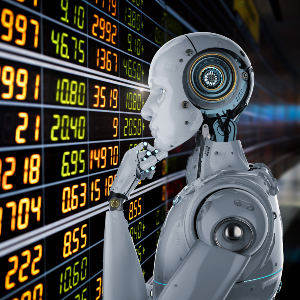
Artificial intelligence (AI) has already made a significant impact on the world of marketing, health, technology, and transportation. And while it’s yet to make its mark on the world of finance, there are already hedge funds and individual investors who rely on AI and machine learning to boost their portfolios and develop trading strategies.
How can AI impact investing, and what is the future likely to bring?
Why Use AI When Making Financial Decisions?
Banking and financial regulatory bodies are using AI to ensure compliance and detect fraud. AI can also go through loan applications and other documents much faster than a human can, and make intelligent decisions based on the parameters it has been taught.
AI can also provide better customer experiences (think of chatbots and email autoresponders), but what we are really interested in is its ability to make investment decisions.
One of the major edges an artificial brain has over the human one is that it is not plagued by emotions. It is able to make decisions based purely on logic and data, thus making it practically impossible to make the wrong choice as a result of anger, lack of sleep, excitement, or misinformation.
AI is certainly far from flawless, and it can never predict market trends with absolute certainty. However, its potential is exponentially expanding.
Impact of AI and ML on Early Adopters
During these initial stages, AI adoption will remain slow. It requires a significant investment in new tools and either training for existing staff or the recruitment of staff already proficient in AI practices.
Most funds still rely on traditional analysis methods because that’s what humans learn in MBA courses. It will take a while before we find a way to seamlessly blend the two methods of analysis.
Those who understand how AI works and know how to mitigate the risks of its use can gain that important competitive edge.
The Risks Involved
The major issue with using AI in investing is that it can produce models that are completely random.
With traditional technical analysis, based on chart patterns and indicators, you draw returns from a distribution with zero mean before any transaction costs. Some traders will thus get it right most of the time due to nothing more than luck. Traders will, however, believe it’s their skills that are making them all that money.
With AI, there are additional variables, such as the bias-variance trade-off. It can result in strategies that work perfectly with old data but that will go bust with new data. Other strategies may also be too simple and not take into account signals that a human would recognize but that a machine can’t see as important.
To remedy the issue, traders relying on AI will need to teach their artificial brains to think better, which requires a lot of time and investment. Small investors and funds have no hope of making it at this early stage, so only large, profitable, established firms can really make solid use of AI.
The Human Factor
We also need to remember that the algorithms AIs learn are written by humans. The better a human understands both the market and the technology, the more successful the project will be.
If you look at a dividend calculator for example, you’ll notice it’s already pretty smart and able to take into account numerous variables. However, it can still miss the mark, as the market can be volatile. There is really no way to predict how an investment will play out, no matter how armed with information you are.
If a human tech teaches its AI piece of technology to think in a flawed way, it won’t be able to make smart decisions in the long run.
What Does the Future Hold?
It is still very difficult to predict how exactly AI and ML are going to impact the world of investing. We may expect more efficient markets with lower volatility over more extended periods of time, interspersed by occasional spikes of volatility caused by regime changes. This might, however, be too bright of a future to hope for.
As the inherently subjective evaluation of humans on the state of finances and investments is minimized, volatility needs to decrease. This can only happen when AIs become intelligent and experienced enough to make competent decisions. They need to grow up a bit more, in other words.
We can certainly argue that the way we currently do things is becoming obsolete. Looking at charts and graphs and making decisions that way is slow and outdated.
The future of investing needs to rely on developing and validating models, as well as processing information in real time. Chart analysis needs to be replaced with real-time action, and that is something only AI can do.
What we need to get there is time. And let us not forget how expensive AI adoption is. While costs are decreasing, it is still a very expensive game to play.
What About Smaller Investors?
As things stand at the moment, smaller investors who do not have the resources to invest in AI have no hope of getting involved in the process early on. If you are working with a fund that has already started implementing AI, you have your entry ticket.
While we don’t expect smaller investors to be significantly outplayed by those who are already using AI in investing, more likely than not, they may face some hardship in the near future. However, the playing field is expected to even out. There will certainly be those who can’t keep up with the game, but investing in blue chip stocks and stable markets will always be an option, although the yields may remain slow.
Wrapping Up
There is certainly a lot to expect from AI in the world of investing. We can’t yet predict how soon it will start to make a more significant impact, but without a doubt, we can expect machine learning to inform more important decisions in the long run.
